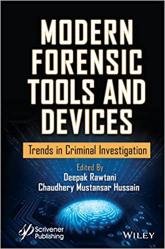Modern Forensic Tools and Devices: Trends in Criminal Investigation
- Добавил: literator
- Дата: 28-05-2023, 05:26
- Комментариев: 0
 Название: Modern Forensic Tools and Devices: Trends in Criminal Investigation
Название: Modern Forensic Tools and Devices: Trends in Criminal InvestigationАвтор: Deepak Rawtani, Chaudhery Mustansar Hussain
Издательство: Wiley-Scrivener
Год: 2023
Страниц: 456
Язык: английский
Формат: pdf (true)
Размер: 12.7 MB
The book offers a comprehensive overview of the latest technologies and techniques used in forensic investigations and highlights the potential impact of these advancements on the field.
Technology has played a pivotal role in advancing forensic science over the years, particularly in modern-day criminal investigations. In recent years, significant advancements in forensic tools and devices have enabled investigators to gather and analyze evidence more efficiently than ever. Modern Forensic Tools and Devices: Trends in Criminal Investigation is a comprehensive guide to the latest technologies and techniques used in forensic science.
This book covers a wide range of topics, from computer forensics and personal digital assistants to emerging analytical techniques for forensic samples. A section of the book provides detailed explanations of each technology and its applications in forensic investigations, along with case studies and real-life examples to illustrate their effectiveness.
One critical aspect of this book is its focus on emerging trends in forensic science. The book covers new technologies such as cloud and social media forensics, vehicle forensics, facial recognition and reconstruction, automated fingerprint identification systems, and sensor-based devices for trace evidence, to name a few. Its thoroughly detailed chapters expound upon spectroscopic analytical techniques in forensic science, DNA sequencing, rapid DNA tests, bio-mimetic devices for evidence detection, forensic photography, scanners, microscopes, and recent advancements in forensic tools. The book also provides insights into forensic sampling and sample preparation techniques, which are crucial for ensuring the reliability of forensic evidence. Furthermore, the book explains the importance of proper sampling and the role it plays in the accuracy of forensic analysis.
Digital forensic a new science has been introduced to handle cyber and digital crimes. The forensic science deals with digital crimes as well as crimes involving digital devices like computers, PDAs etc. Most of the processes are being automated due to rapid development and advancement of digital computing and communication technologies. With increasing of information and internet technologies confidential information is stored on computer based systems and majority of people share their information on popular social media networks such as Twitter, Instagram, Facebook, Linkedin, Youtube, etc. There is a significant growth in crimes in the whole world due to the progression of communication and information technology.
Network security deals with the detection and prevention of the bug and virus attack in any system. It includes detection of firewalls and use of anti-virus tools. Nowadays, attackers have become skillful and knowledgeable, due to which by using different tools and sources, one is not able to detect the bug in the system. This make it more important to work on network security to identify the attacker and to improve the condition of systems. Network security helps in collection and detection of data packets that are derived from different sources to analyze those and to prevent future attacks [8]. Not only network forensic determine the attackers, but it also helps in real-time monitoring, threat intelligence-event correlation, in-depth analysis of possible threat and troubleshooting.
EnCase Forensic Imager Tool is flexible and used for complete investigation for network and data analysis. It can be used to obtain data from different devices including mobile phones, tablets, windows, iOS, and many others.
Paladin Forensic Suite was developed with the idea of Ubuntu so that analysis in forensic science can be made easy. Paladin Tool provides an easy way to search videos and images in the digital devices. It has been classified on the basis of categories being searched on like Social Media Analysis, Video Examination, Image Detection Tools, and others.
Digital Forensic Framework (DFF) investigation tool has been created on an altered Application Programming interface with an open source. It can extract data that has been deleted from USB and other storage devices. It can also derive web browse history data if deleted and can also extract letter drops from Microsoft.
The use of social networking is changing its shape by gradually transitioning towards social network chat (SNC) applications. The rise in usage of smartphone-based SNC applications has significantly raised users’ concern for security and privacy. SNC applications privacy and settings are different than the classic web privacy settings. These differences can result in sensitive information leakage. This paper focuses on identifying what sensitive information can be obtained by persuading the users to forward or open the forwarded unknown/malicious URL links in nine different SNC apps. Four Android phones and four Apple iPhones having different versions of latest Operating Systems were used in the analysis. From the results, it was found that certain device information (like model no, model name, OS version), user information (like IP address, ISP, network operator, geolocation), app information (like version, name) can easily be obtained from these apps. Such private information is likely to be misused by attackers in profiling of users. Certain information like IP address and geolocation can be useful for law enforcement agencies in electronic surveillance of criminals or suspects. Our research also identifies what users and developers can do to prevent such leakage.
Audience:
The book is an essential resource for forensic scientists, law enforcement officials, and anyone interested in the advancements in forensic science such as engineers, materials scientists, and device makers.
Contents:
Скачать Modern Forensic Tools and Devices: Trends in Criminal Investigation
[related-news] [/related-news]
Внимание
Уважаемый посетитель, Вы зашли на сайт как незарегистрированный пользователь.
Мы рекомендуем Вам зарегистрироваться либо войти на сайт под своим именем.
Уважаемый посетитель, Вы зашли на сайт как незарегистрированный пользователь.
Мы рекомендуем Вам зарегистрироваться либо войти на сайт под своим именем.

